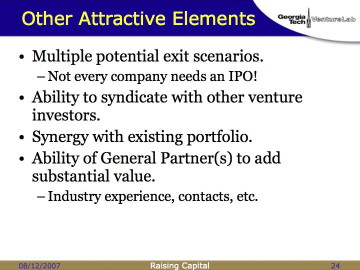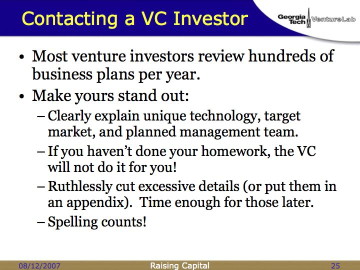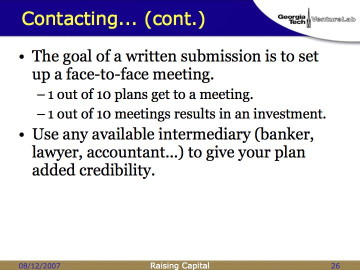This is a continuation of a previous set of posts and is seventh in a series.
Okay. This post probably should have been the end of the previous entry, but I was lazy.
Let’s say you’ve met all five criteria in the last few slides. Good for you! Unfortunately, so do a bunch of other deals. All things being equal, VCs will use secondary elements to make decisions on who to invest in.
This is your chance to shine! But it involves doing your homework.
Everyone can throw the sentence “We expect a liquidity event via IPO or M&A after reaching profitability in Year Five.” Yawn.
Dig deep and provide some detail here:
We expect to be an attractive acquisition target to major players in multiple industry sectors. [List those sectors.] In the widget space, potential acquirers include A, B, and C. [Obviously, list their real names… Google, Boeing, Pfizer, whatever.] “Player A” has acquired three companies in the last five years [list them], paying an average of 8.7X earnings. According to our projections, that would value us at $125M.
“Player B”… etc.
In the blivet sector…etc.
You get the idea. Remember, the VC doesn’t make money when you sell your product; he (or she) makes money when you sell your company! Get them excited about what that sale might look like.
Most VCs will want to syndicate your deal… meaning share it with other similar investors. Frequently, the same two or three firms will do multiple deals together. When you’re targeting a particular VC, figure out who their favorite partners might be, and do your homework on them, too.
What sort of homework? Synergy with the existing portfolio is a big one. If you can say “I know that you’ve invested in companies A and B. Here’s how our product can extend their functionality, and why we’d make good partners for them, and here are some customers that we could attack together”… you have just demonstrated that you’ve done your homework, and that you understand the nature of the VCs job.
Don’t force-fit a synergy if one doesn’t exist… but if there is one, be sure to point it out.
Finally… most VCs used to do something else. Do your homework on them as individuals, not just as representatives of their fund. For example, I used to be a telecom geek, so I’m a sucker for telecom deals… especially ones where my (sadly, aging) Rolodex can help out by identifying a customer contact, or a key hire, or a sympathetic analyst.
None of these elements are secret. VC Web sites leave literally hundreds of trails to follow, and Google is your friend.
Unless you’ve already demonstrated your ability to make millions for your investors in prior deals, you’re going to have to prepare a business plan before talking to VCs. (You’ll have to do one in any event, but if you’re less experienced, it’s earlier rather than later.)
Fact of life: VCs are deluged with business plans. I’ve been handed business plans at conferences… at restaurants… one foolish but enterprising fellow even drove up to the front door of my house and rang the doorbell. (Yes, I’m in the book. It’s not an open invitation. Don’t do that.)
It used to be that the expense of printing and shipping business plans provided a rough-and-ready filter… but those days are gone. The cost of emailing a PDF file is zero… so a lot of PDFs get emailed. VCs have to separate the wheat from the chaff very, very quickly. His or her default state is going to be “What reason am I going to find to reject this one?” You have to break through that… getting them past each internal objection until the logical next step is to invite you in for a presentation.
At this point, your business plan is a marketing document as much as it is anything else. You get twenty pages before the VC gets bored and rejects you out of frustration. In the first two pages, and then again in the next eighteen, you have to clearly explain your value drivers (see previous post).
You may have to write 200 pages to crystallize all your ideas. That’s fine; it’s not wasted. Don’t throw those pages away. But you’re going to have to compress everything into twenty clearly-written, hard-hitting pages before sharing with a VC. There will be time enough for the 200-page version if and when you get to the “due diligence” phase. Later.
And, finally, I tend to tick off engineers with my last point, especially those engineers who weren’t born in the United States: Spelling counts. And I’m using that as shorthand for all the mechanical details of creating a document… spelling, grammar, consistent typefaces, lining up tab stops, page numbers, all those picayune details that have nothing to do with the quality of your idea. Why do I care?
You’re creating a document that you’re going to send out into the wild alone. When someone reads it, the words (and graphics, if any) on the page have to communicate your vision without you being there. So that document needs to represent your best work. And I treat it like a Rorschach blot of what I would see from you as a CEO… do you pay attention to detail? Are you logically consistent? If spelling isn’t your strong suit, can you recruit someone to help you who’s better at it than you are? What’s it going to be like to work with you?
If the business plan reflects that you’re either sloppy or lazy or stupid, I am going to assume that you’re sloppy or lazy or stupid as a CEO. That’s not a good motivation for me to invest in you.
Remember how I said, at this point, your business plan is a marketing document? That’s because its main purpose at this point is to get you to a face-to-face meeting with potential investors.
I’m showing that “1 out of 10 plans get to a meeting; 1 out of 10 (initial) meetings results in an investment.” That’s actually a bit optimistic, but whether the odds are 100:1 or 300:1 against you, the message is the same… you have to stand out.
Human nature being what it is, one of the best ways to stand out is to be recommended by someone the investor knows and trusts. Some firms will publicly state that they never invest in deals that aren’t sourced through their network. Other firms aren’t as blunt about it, but the reality is the same. Mass-mailing your plan to a dozen (or a hundred, or a thousand) VCs is a complete waste of time and resources on both ends. Repeating the theme from earlier slides: do your homework, target your potential investors carefully, then figure out how to get to them through a trusted intermediary.
Cynics will say “It isn’t what you know, it’s who you know.” Not necessarily. If you and your target VC don’t have any friends in common (but you might be surprised; check what LinkedIn has to say), go make some new friends. Lawyers, accountants, recruiters… their lifeblood is relationships, and they’re easy to make contact with. Buy a few breakfasts or lunches; it’s a cheap investment to build those relationships.
For the mechanics of developing a business plan… next post.
Is anybody reading this? Annotating these charts is taking a lot more time than I expected, and I’m barely halfway through. And from the echoing silence on the Comments pages, I wonder if I’m just talking to myself…



Hi Stephen,
Thank you very much for the series of blog posts. I heard you give your presentation at BarCamp but it’s nice to have the blog posts as a reference. Timely as well since I’m going to be actively pursuing funding for my company.
I like this blog is fantastic, is really good written. Congratulation. Do you want to see something more? Read it…: Great investment opportunity in Costa Rica: houses for sale, homes for sale, investment property. Visit us for more info at: http://www.jaco-bay.com/
Oh, frabjous day. My first blog spam.
Sigh.
long tail, long tail … these slides are awesome.
I’m lurking but reading. I think there are more like me.
Good stuff, and we’re definitely reading (even if it’s a month later).
Great material… hope I get to see you give it in person some day.
I love this series. I’ve just added your blog to my rss reader
and I’m still reading it, and refering to it, and sending it to my professors and classmates 8 months later. valuable info in this series.